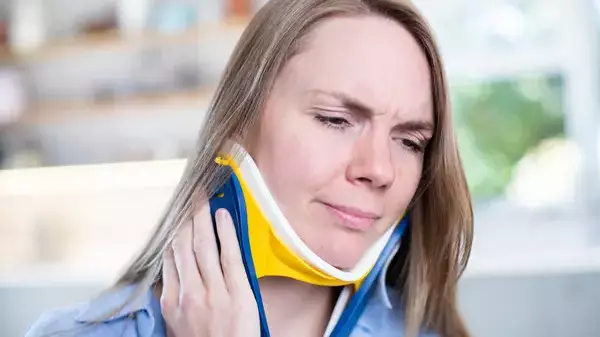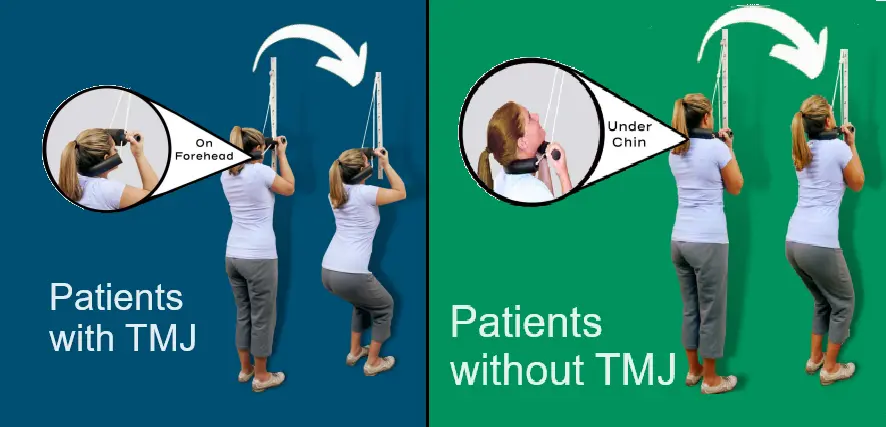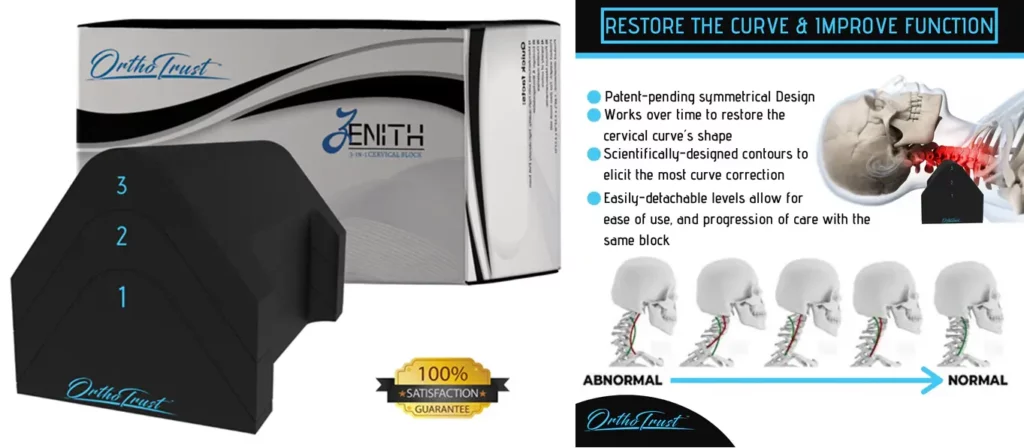Contraindications for cervical traction should not prevent you from safely using it to relieve neck pain. Cervical traction is a safe and effective method for treating neck pain. It involves gradual and careful neck stretching to temporarily increase the space between the vertebrae (the intervertebral disc), which helps reduce pressure on spinal nerves and relieve pain in the cervical spine. This method is mainly targeted at the cervical spine.
Table of Contents
ToggleHow Does Cervical Traction Work?
The primary function of cervical traction is to pull the head away from the neck. This action helps expand the space between the cervical vertebrae, effectively eliminating compression that often leads to pain. Devices used in this treatment lightly stretch the neck, enhancing the separation of the vertebrae and thus mitigating pressure on the spinal column.
Applications and Benefits of Cervical Traction
Cervical traction, a versatile non-surgical treatment, is effective for different cervical spine conditions. These conditions include herniated discs, neck sprains, and general neck pain. Separating the vertebrae helps reduce the pressure on compressed nerves, improves the alignment of the cervical spine, and promotes a better posture. This separation also facilitates increased blood flow and nutrients to the affected areas, fostering a better healing environment.
Considerations Before Beginning Cervical Traction
Patients must consult their healthcare providers before starting cervical traction. This pre-treatment consultation with a Chiropractor in Denver is a responsible step that helps customize the traction approach to meet individual needs effectively and safely. Understanding these essential aspects of cervical traction allows you to choose the best options for treating cervical spine conditions.
Understanding Cervical Traction
Cervical traction is a therapeutic technique involving careful traction (stretching) of the neck to alleviate various conditions. This section delves into the methods and mechanisms of cervical traction, highlighting both manual and mechanical approaches.
Different Types of Cervical Traction
This treatment can be administered manually by a healthcare professional or through mechanical devices. These devices range from simple over-the-door setups to more sophisticated machines and harnesses. For those who prefer home treatment, we offer two options to our patients. The Pettibon System Portable Cervical Decompression unit and the OrthoTrust Cervical Block.
Methods of Cervical Traction
- Manual Cervical Traction
- This is performed by a healthcare provider who holds the patient’s head and gently pulls it away from the body, creating space within the cervical spine.
- Mechanical Cervical Traction
- Utilizes devices such as the OrthoTrust Cervical Block or Pettibon System Portable Cervical Decompression unit, which apply a gentle, even pull on the head according to specific force and angle guidelines.
- Over-the-door traction systems employ a pulley and weight system, offering a practical solution for outpatient treatment.
Goals of Cervical Traction
- The primary goal of cervical traction is to stretch the neck gently. This action helps separate the vertebrae, reducing pressure on compressed nerves and increasing the space between discs.
- The process promotes the flow of oxygen and nutrients to the affected area, improving spinal alignment, reducing abnormal curvature, and enhancing posture.
- The theory behind cervical traction suggests that widening the intervertebral foramen and separating the facet joints during traction relieve pressure on nerve roots, alleviating symptoms of conditions like radiculopathy.
Professional and Home-based Cervical Traction Devices
- A Chiropractor in Denver can perform cervical traction professionally using specialized traction tables and manual techniques.
- Home traction units, over-the-door traction devices, and cervical pillows and rolls are available for home treatment. These allow patients to manage their condition conveniently without visiting a healthcare facility.
This comprehensive understanding of cervical traction’s methods, mechanisms, contraindications for cervical traction, and applications underscores its role as a versatile and effective treatment option for cervical spine issues.
Common Uses of Cervical Traction
Cervical traction is a versatile therapeutic approach that can be applied to various cervical spine conditions. This versatility underscores its broad applicability and diverse benefits across various medical scenarios.
Temporary and Chronic Conditions
Cervical traction is instrumental in treating temporary and chronic conditions, providing relief, and fostering recovery. The method is effective in managing:
- Temporary Conditions:
- Radiculopathy: Relieves pressure on nerve roots caused by spinal abnormalities or injuries.
- Neck Sprains: Aids in healing soft tissue injuries within the cervical spine.
- Spinal Fractures: Supports the alignment and stabilization during the healing process.
- Chronic Conditions:
- Spinal Stenosis: Alleviates symptoms by expanding the spaces within the spinal structure.
- Degenerative Disc Disease: Cervical traction helps slow the progression of disc degeneration and associated pain.
- Cervical Spondylosis: Addresses wear and tear of cervical spine disks and joints.
- Scoliosis: Assists in managing the abnormal lateral curvature of the spine.
Conditions Treated With Cervical Traction
Cervical traction is also applied in the treatment of various specific cervical conditions, enhancing its utility in clinical settings:
- Cervical Disc Disease: Traction helps reduce the effects of worn or herniated cervical discs.
- Cervical Spine Fracture: Used in the post-traumatic recovery phase to maintain spinal alignment.
- Facet Joint Dislocation: Helps realign dislocated joints and reduce pain.
- Occipitocervical Synopsis: Addresses the congenital or acquired connections between the occipital bone and cervical spine.
- Foraminal Stenosis: Increases the space between the vertebrae to relieve nerve compression.
- Myofascial Tightness: Eases muscle stiffness, enhances mobility, and relieves pain.
Conditions You Can Treat with Cervical Traction
The benefits of cervical traction extend to many conditions:
- Arthritis: Cervical traction reduces inflammation in the joints of the neck through gradual stretching.
- Pinched Nerves: At-home cervical traction relieves neck pain by stretching inflamed joints and cervical discs, relieving pressure on the spinal nerves.
- Misalignment of Cervical Vertebrae: The wrong type of cervical traction (“axial” traction) can worsen spinal misalignments. The two devices referenced below are designed to remove pressure on the joints in the neck while maintaining the cervical curve.
- Herniated Discs: Cervical traction can decrease pressure on the intervertebral discs in the neck, promoting healing and reducing recovery time.
- Muscle Spasms: You can gently stretch tight muscles to relieve tension and spasms.
By utilizing cervical traction, healthcare professionals can offer a non-invasive treatment option that effectively addresses a broad spectrum of cervical issues, enhancing patient care and recovery.
Benefits of Cervical Traction
Pain Relief and Relaxation of Tight Muscles
Cervical traction is a proven treatment for alleviating neck pain. It eases muscle spasms and prevents muscles from contracting and shortening. This reduction in muscle tension helps decrease pressure on the nerves, offering significant pain relief.
Improved Blood Flow and Nerve Function
Cervical traction helps relieve nerve pressure exiting the spine, promoting muscle relaxation. Relaxing tight muscles helps improve blood flow, reduce nerve pressure (which can enhance nerve function), and relieve pain. All of these are crucial parts of the healing process and the overall health of the cervical spine.
Treatment of Different Types of Neck Conditions
This therapeutic approach is utilized in managing various neck conditions, including arthritis, pinched nerves, cervical disc disease, misalignment of cervical bones, spondylosis, stenosis, and scoliosis. Cervical traction helps address these issues by correcting deformities and providing rest to injured areas, thus promoting recovery.
Improvement in Neck Mobility and Motion
Regular use of a cervical traction device can improve neck mobility. Cervical traction reduces stiffness, improves flexibility, and helps to hydrate degenerated intervertebral discs, significantly improving the quality of life for people with chronic neck issues.
Cervical Traction as Alternative to Surgery
Traction can offer fast relief from aching, burning, numbness, tingling, and weakness in the arms and legs. It also treats general neck pain by reducing compression and stretching muscles and joint structures around the neck. It serves as an alternative treatment option that can help individuals avoid more invasive procedures like surgery, providing a safe, effective, and inexpensive way to manage neck pain at home or in a clinical setting. The dangers of cervical traction pale in comparison to the dangers and potential adverse effects associated with cervical spinal surgeries.
Contraindications for Cervical Traction
General Contraindications
- Pregnancy and Anxiety Concerns
- Cervical traction is not recommended for pregnant women, individuals who experience severe anxiety or claustrophobia, and those with a history of being uncomfortable with restraint.
- Bone and Spinal Conditions
- Individuals with conditions that compromise bone strength or spinal integrity, such as osteoporosis, osteomyelitis, or those with spinal cord tumors, should avoid cervical traction.
- Cardiovascular and Respiratory Issues
- Those with aortic aneurysm, untreated high blood pressure, or restrictive lung disease are advised against using cervical traction due to potential health risks.
- Neurological and Muscular Concerns
- Conditions such as myelopathy, acute torticollis, or herniated discs with midline protrusion may worsen with cervical traction.
- Infections and Inflammatory Diseases
- Active infections like osteomyelitis or inflammatory conditions such as active peptic ulcer disease are contraindications for cervical traction.
Specific Medical Contraindications for Cervical Traction
- Aortic Aneurysms and Dislocations
- Individuals with known aortic aneurysms or joint dislocations should not undergo cervical traction due to the risk of exacerbating these conditions.
- Spinal Cord Compression and Fractures
- Cervical traction is contraindicated in patients with spinal cord compression, vertebral fractures, or those with extruded disc fragments.
- Joint Instability and Degenerative Diseases
- Patients with ligamentous instability, severe osteoporosis, or chronic cervical disc degeneration should avoid cervical traction to prevent further joint or bone damage.
Patients with ligamentous instability, severe osteoporosis, or chronic cervical disc degeneration should avoid cervical traction to prevent further joint or bone damage.
Monitoring and Professional Consultation
- Neurological Monitoring
- It is crucial to monitor your symptoms for neurological changes during cervical traction. Cervical neurological symptoms include radiating pain, numbness, and/or tingling.
- Multi-faceted Approach
- Using a variety of treatments in conjunction with cervical traction helps to maximize improvement and minimize treatment time.
- Consult With a Spinal Professional
- Speak with your Chiropractor before beginning cervical traction. It’s vital to consider the different aspects of your specific condition before beginning your cervical traction. This ensures the safety and effectiveness of your treatment.
Cervical Traction Precautions and Considerations
Initial Consultation and Diagnosis
Before undergoing cervical traction, a healthcare provider must conduct a thorough diagnosis to determine the suitability of the treatment for the patient’s specific condition. This initial consultation ensures that cervical traction is an appropriate therapeutic option.
Consult Your Chiropractor
You should always consult with your Chiropractor before using a cervical traction device, especially when planning to use one at home. This crucial step ensures the safety and effectiveness of the treatment.
Monitoring and Adjustment
- Monitoring Vital Signs: It is critical to monitor vital signs before and immediately after cervical traction for high-risk patients, particularly those with high blood pressure or cardiac issues.
- Symptom Monitoring: It is important to monitor symptoms during and after using the device. If patients experience increased pain, numbness, or other adverse effects, they should discontinue use and consult a healthcare provider.
- Response to Treatment: Be aware of the dangers of cervical traction. If new pain, numbness, or tingling in limbs, changes in vision, or headaches occur, patients should stop using the device immediately and contact a healthcare provider.
Picking the Right Cervical Traction Device
- Proper Device Selection: Choosing a suitable device is vital for the safety and success of cervical traction. Patients should seek professional advice to select the most suitable device.
- Following Manufacturer’s Instructions: Adhering to the manufacturer’s guidelines and healthcare professional’s advice on correctly using the cervical traction device is essential.
- Device Maintenance: The cervical traction device must be properly maintained and stored regularly to ensure its safety and effectiveness.
Technique and Treatment Options
Cervical traction can be performed using various methods, including manual cervical traction, mechanical cervical traction, over-the-door traction, and intermittent traction. Each technique has specific applications and should be chosen based on the individual’s condition and comfort.
Other Options for Treating Neck Pain
While it can be beneficial, cervical traction is only one of the many effective treatments for neck pain and stiffness. Other treatments include:
Home-Based Cervical Traction Devices
“At-home” cervical traction devices can be beneficial when treating neck pain and radiating symptoms. These include over-the-door cervical traction and simpler ” low-tech” units that are ideal for home and easily packed when traveling.
A popular “over-the-door” traction unit is the Pettibon System Portable Cervical Decompression unit. These units are inexpensive, easy to use, effective, and avoid the more common dangers of cervical traction. A simpler device that we provide to our Integrative Health and Rehab patients is the OrthoTrust Cervical Block.
Directions for Pettibon Cervical Traction Unit*
- Before using the Pettibon cervical traction unit, perform cervical warm-ups before beginning traction (twist, flex, and extend head/neck).
- The curved piece of the unit should hang slightly lower than the back of the head. Adjust the unit accordingly, tie or loosen knots, or move the unit up or down the wall mount.
- Pull the straight bar down by the handles until stopped by the curved neckpiece. The handles should be about shoulder height.
- Elbows and knees should be against the wall or door, and feet should be shoulder-width apart.
- Place the curved piece behind your neck and pull the padded straight bar under your chin for a non-TMJ model or right above the bridge of your nose on your forehead for the TMJ version.
- Place each hand on handles with palms toward your face.
- Hold the handles firmly, relax the knees, and sink down with about 20% of your body weight supported by the unit. Exhale deeply with each “squat” motion.
- Stand back up, relieve the pressure of the traction, and inhale.
- Begin with 10 repetitions of the sinking and stand motion, coordinating your breathing. Work your way up to 60 reps.
- When finished, apply ice or a cold pack to the neck if you experience any soreness.
*For complete instructions on safe use, refer to the instructions included with your Pettibon Cervical Traction Unit and the directions provided by your doctor.
 Directions for OrthoTrust Cervical Block
Directions for OrthoTrust Cervical Block
- The OrthoTrust Cervical block is made of three stackable pieces. When beginning, start with the first tier of the block. You can add additional levels as you become more comfortable with this type of cervical traction.
- Place the cervical block on a firm surface (e.g., floor or mattress). Lay down and position yourself so the block is placed at the base of the neck. To find the correct spot, place your fingers at the base of your skull, apply slight pressure, and slide down the spine until you feel the 1st thoracic vertebrae. This is the base of the cervical spine, where the neck meets the upper back. The cervical block should be placed perpendicular to your neck.
- While lying on the cervical block, your face should be parallel to the ceiling. Your neck muscles should be relaxed, and your chin should not be tucked in any way.
- When first beginning with the cervical block, lie down for as long as is comfortable but no more than 15 minutes. If you are unable to find a pain-free position, lie only as long as it is tolerable.
- Increase time on the second day and then gradually add time the following days for a maximum of 10-15 minutes per session.
- When finished using the cervical block, do not raise your head from the device quickly. Instead, gently cradle your head and roll it off to the side. Sit up once you are comfortable.
- Once you can lay comfortably on the cervical traction block for 15 minutes, add the next level of the block.
- If you struggle to get comfortable on the block or have a flare of neck pain, place a cold, flexible gel pack on top of the traction block.
- One of the prime benefits of using the cervical block is it does not expose you to some of the dangers of cervical traction that other devices have.
 Effectiveness and Contradictions for Cervical Traction
Effectiveness and Contradictions for Cervical Traction
Cervical traction is a noninvasive way to provide symptomatic relief for many neck problems. However, the long-term benefits of cervical traction are not well-studied, and relief may only be temporary. Therefore, consider this treatment part of a broader management plan and consult a Denver chiropractor to find the best treatment for your neck pain to avoid the dangers of cervical traction.
FAQs
1. What conditions should prevent the use of neck traction?
Neck traction should not be used if conditions compromise or destabilize the neck’s structure. The dangers of cervical traction are increased for those with spinal tumors, infections, and rheumatoid arthritis. Additionally, neck traction should be avoided if that type of stress or motion advised against for your specific medical condition.
2. Can you list some contraindications for cervical traction and precautions for using spinal traction?
Certain conditions serve as contraindications or call for caution when using cervical or lumbar traction. These include acute torticollis, aortic aneurysm, ankylosing spondylitis, advanced age, osteomyelitis, osteoporosis, and ligamentous instability. Be sure to consult with your doctor before beginning any spinal traction program.
3. What are the potential dangers of undergoing cervical traction?
The dangers of cervical traction can be pronounced if you have conditions that weaken the bones or affect the spinal cord, such as aneurysms, osteoporosis, osteomyelitis, spinal cord tumors, myelopathy, or untreated severe hypertension.
4. What are some specific contraindications for using cervical traction?
Contraindications for cervical traction include open wounds near the area of treatment, fractures or dislocations in the cervical spine, severe osteoporosis, and certain neurological disorders. Don’t dismiss the potential dangers of cervical traction.
Need more help managing your neck pain? Contact us! A Denver Chiropractor at Integrative Health and Rehabilitation will give you honest answers as to what is causing your neck pain and what we can do to help you. If we don’t think Acupuncture, Chiropractic, Dry Needling, or Shockwave Therapy will help your specific problem, we’ll tell you! Still not sure if we can help? Please read some of our 5-star reviews and see we are the affordable Chiropractic clinic Denver seeks for fast, effective, and lasting pain relief.. We’ve been helping patients in Arvada, Denver, and Wheat Ridge, Colorado, for over 20 years. Learn more about the conditions we treat on our Health Articles page. Ready to start feeling better? Book an appointment online!

Ready for an expert opinion? Get in touch today!
With a legacy of more than 25 years, our team specializes in helping individuals triumph over back pain, neck discomfort, and persistent headaches, all without relying on addictive medications or risky surgical procedures.









